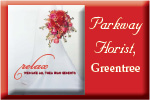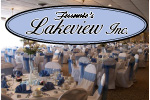Selecting a Florist
Once considered part of the background scenery, flowers have moved into the foreground of wedding planning. The trend is toward flowers that are fresher and in-season, and more of them—for decorating the exterior of the ceremony site and even on the wedding cake.
The first step is to find a reliable and experienced florist. Get recommendations from family members and friends. Ask the church or synagogue’s wedding coordinator, your caterer, or bridal consultant for suggestions.
Before meeting with a florist, work up an accurate list of the number of bouquets and arrangements you will need.
In addition to your bouquet, you will need flowers for the attendants, flower girl, mothers, grandmothers, Godmothers, guest book attendant, female greeters and readers. Boutonnieres will be needed for the groom, groomsmen, ring bearer, fathers, grandfathers, male greeters and readers.
You may want wreaths, bows or arrangements for the church doors, vestibule displays, altar or chuppah arrangements, pew markers, candelabra bouquets, garlands for the aisle or altar railings, sign of peace roses, unity candle arrangements, and/or faith-specific floral tributes.
For the reception you may need arrangements for the head table, candelabra, guests’ tables, buffet tables, parents’ table, ice carvings, wedding cake (including the knife and table), a toss-away bouquet, entrance vestibules, and restrooms. Of course this may change as you hear new ideas and get estimates of everything you want.
Set a realistic budget before meeting with a florist, but don’t let your budget limit your imagination. A creative florist will be able to modify designs to suit your imagination as well as monetary constraints.
Money Saver Tip: If there is more than one wedding at a church, consider the idea of sharing flower costs.
Take time to visit several florists and ask to see photographs of their work. Compare flower quality,
craftsmanship, and design. Ask for and contact references. Arrange to visit a ceremony and/or reception site just after it has been set up, before guests arrive. This will give you an excellent overview of their work.
Ask each florist to provide you with a written estimate. Inquire about cancellation, deposit, payment, and refund policies.
Selecting the Arrangements
Remember that while you can get most flowers year round, buying flowers in season will save you money, and ensure quality and availability. NOTE: Remember that florists experience heavy demand for flowers on certain holidays (Valentine’s Day, Mothers Day).
There are many details to consider when choosing bouquets and arrangements. Obtain fabric swatches from all gowns and dresses. Try to get enough fabric so you can leave a sample with the florist for matching flowers, ribbons, tulle, and other accents.
Photographs of your gown and attendants’ gowns will be very helpful. Photographs of the interior of the ceremony site and reception sites will help if your floral designer has never worked there. Also inquire about any restrictions.
Your dress, color scheme, style, season, and time of day of the wedding will impact floral selections. Church arrangements need to present a dignified yet joyful quality, keeping with the majesty of the building.
When choosing arrangements for the reception, keep in mind the color of the walls and height of ceilings. The trend is toward smaller vases to allow open conversation around the table. The room’s lighting may also influence floral design. Dimly lit and large rooms benefit from dripless candles, votive lights or small table lamps.
If you do not know how many centerpieces you will need, estimate the number of tables by counting the number of guests invited (excluding those who will be sitting at the head table), subtracting 10 percent and dividing by the number of seats at each table. Remember that this number can be adjust
ed later.
Your bouquet and the attendants’ bouquets will enhance the head table beautifully. A long bow on the head table can tie in your wedding flowers and colors.
To ensure continuity of design, have your florist also design flowers for the cake and ice sculptures. Be sure to keep the baker, florist, and ice sculptor in communication to avoid conflicts.
Bridal Bouquet
The style of your bridal bouquet must complement both your dress and your form. Trailing cascades will overwhelm petite brides, while large or tall women may look awkward carrying a small nosegay. Gowns with elaborate detailing at the waist and/or the skirt require smaller bouquets. Plain-skirted gowns permit the use of more elaborate cascades or crescent bouquets. You may opt to carry a basket of flowers, floral fan arrangement, parasol bedecked with flowers, or a decorated Bible or prayer book.
Attendants’ Bouquets
Your attendants should carry bouquets that complement your bouquet as well as the style and color of their gowns. The honor attendant’s bouquet may match the bridesmaids’ or be a little more elaborate. Solid color pastel gowns can be enhanced by vivid colors or in tone-on-tone arrangements. White flowers are dramatic against deeper, jewel-toned dresses. Multicolored/print dresses benefit from monochromatic bouquets in undertone colors in the fabric.
Other options include wreaths, decorated candles, tussie-mussies (Victorian cone-shaped flower holders, often made of silver), sprays of pine or greenery, wrist bouquets, or small sprig bouquets attached to velvet muffs. A small sprig for the hair also adds a nice touch. Take into consideration your attendants’ hairstyles, as sprays can either be attached with small combs or bobby pins.
Flower girls can carry miniature bouquets, baskets of ivy, flowers and/or flower petals, wreaths or muffs.
Corsages
Flowers for the mother and grandmothers should complement their dress
es. Consider the body flower corsage, which pins to the dress at the top of the shoulder. Not only does this prevent the pulling of sheer and lightweight fabrics; it can be seen from behind as well. Mothers may also carry a small bouquet. Some dresses are perfect for waist corsages. Elaborately detailed dresses may call for wrist or purse corsages.
Remember, too, your Godmothers, greeters, readers, and guest book attendant. If you do not know what they are wearing, select a small tasteful corsage in white. Be sure the florist can quickly adapt it from shoulder to wrist corsage at the church if needed.
Boutonnieres
The men involved with the wedding wear boutonnieres on their left lapel. The trend is toward more elaborate and accented boutonnieres for the groom’s to match the bride’s bouquet. The best man, groomsmen, ring bearer, fathers’, grandfathers’, and Godfathers’ boutonnieres may either contain sprays that coordinate with their female counterparts’ flowers or consist of a simple rose or carnation.
Details
Before the wedding day, decide what you will do with all of your flowers from the ceremony and reception. Arrangements from the ceremony may be able to be taken to the reception site and used there to save money. Check with your officiant and see what their restrictions are. If there are no more ceremonies after yours, some churches would love to have the arrangements for their upcoming services. Likewise, if you are getting married around Easter or Christmas, the church may already have flowers that would enhance your ceremony while saving you money.
If you want your family and friends to be able to take home table arrangements from the reception, be sure to inform the florist. Arrangements can either be placed in less expensive bases or designed to be detachable, individual, arrangements allowing each guest to take one home.
Another option is to take your leftover flowers to a retirement home, hosp
ital, or shut-ins in your neighborhood. Provide your florist with the names and phone numbers of the officiant and/or church’s wedding coordinator, your bridal consultant, reception site contact, caterer, baker, ice sculptor, etc. This will allow them to contact the other professionals and coordinate directly with them concerning details. Be sure you appoint someone to answer questions the florist may have about placement at the ceremony and reception. Be sure to check out the Florist Worksheet under: For Brides: My Bridal Suite
Questions for Your Florist
1. How many weddings do you accept per date?
Florists with too many commitments may not be able to give your wedding the attention it deserves.
2. Can you work with fresh, silk, or dyed flowers depending on my taste?
As long as the florist you choose can fulfill your needs, it doesn’t matter if they handle all types of flowers.
3. What other accessories do you rent or sell?
Many offer aisle runners, candelabra, mirrors, pedestals, topiary trees, potted plants, trellis’ and canopies, among other items.
4. How much of a deposit do you need to hold a date? Is it refundable?
Be prepared to leave a 10-20 percent deposit of the estimated costs to reserve the date.
5. Are there extra delivery charges?
This may be included in the cost. Also ask about returning any vases and rented items - Will they collect them or do you have to return them?
6. Will you visit the ceremony and reception sites if you’re not familiar with them?
Your florist could offer many suggestions after seeing the locations.
Floral Preservation
Your bouquet and other mementos of your wedding day can be beautifully preserved under glass by local artisans. Your bouquet can be mounted alone or with a copy of the invitation, placecard, handkerchief, garter, and other memorabilia.
The process begins with delivering your bouquet
the day after the wedding to the preservationist. The bouquet is then freeze dried or dried in silica gel. Drying can take two to four weeks. Once dried, it can be arranged either whole or in portions on your choice of background. It is then covered with convex acrylic or glass and placed in a frame. The entire process can take six to twelve weeks or longer.
Choosing Flowers to Preserve
If you are interested in this type of keepsake, discuss the matter with your florist and preservationist. The style of your bouquet will dictate whether it can be preserved as is, or if it will need to be dismantled.
Choose your florals with care since not all flowers can withstand the preservation process. Flowers that dry beautifully include the rose, lily, orchid, carnation, alstromeria, gardenia, hydrangea, calla lily, daffodil, iris, lilac, and tulip.
Chrysanthemums and daisies do not preserve well.
Preservation Details
If you decide to have your bouquet preserved, make arrangements with the preservationist at least one month in advance. Arrange to have someone (your maid of honor, mother, sister) refrigerate your bouquet overnight and deliver it to the preservationist the next day. Be prepared to leave a deposit of at least 50 percent when dropping it off. The balance will be due upon completion and pick up. |




















